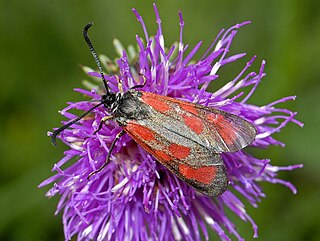Subfamily Procridinae

- Adscita statices , forester — south & centre (local) ‡
- Adscita geryon , cistus forester — south & centre (Nationally Scarce B)
- Jordanita globulariae , scarce forester — south (Nationally Scarce A)
The family Zygaenidae comprises the "forester and burnet moths", of which ten species occur in Great Britain:


Species listed in the 2007 UK Biodiversity Action Plan (BAP) [1] are indicated by a double-dagger symbol (‡).

The Zygaenidae moths are a family of Lepidoptera. The majority of zygaenids are tropical, but they are nevertheless quite well represented in temperate regions. Some of the 1000 or so species are commonly known as burnet or forester moths, often qualified by the number of spots, although other families also have 'foresters'. They are also sometimes called smoky moths.

The six-spot burnet is a day-flying moth of the family Zygaenidae.

Zygaena transalpina is a moth of the family Zygaenidae.

Zygaena is a genus of moths in the family Zygaenidae. These brightly coloured, day-flying moths are native to the West Palearctic.

Zygaena ephialtes is day-flying species of burnet moth found in Europe. It is typically found in xeric habitats, and populations have recently decreased. It also exhibits Müllerian mimicry with other species, like Amata phegea.

Zygaena fausta is a member of the family Zygaenidae, the day-flying burnet moths. Its bright aposematic colours of red, white and black on the wings indicate to possible predators such as birds that it is foul tasting or poisonous. In flight, the bright red abdomen is revealed, contrasting with the white legs and black head and antennae; the thorax is black and white with an eye spot on each side. There appears to be a considerable variation in pattern among specimens from different parts of Europe.

Zygaena loti, the slender Scotch burnet, is a moth of the family Zygaenidae. It is a diurnal moth characterized by a black body, light colored legs, and red spots on its wings. The caterpillars are a yellow-green color and usually molt out of dormancy in late February to early March. The larvae feed on plants from the family Fabaceae until they enter their pupal stage and mature into adults in May to early June. For mating, Zygaenidae exhibit a dual-partner finding strategy, where females use pheromones while assuming a calling position, and males exhibit a patrolling behavior where they utilize both vision and the olfactory receptors in their antennae to locate a potential mate. Although regionally endangered as their population is declining, Z. loti is found all across Europe, inhabiting areas rich in their desired food plants: lime-rich, and characterized by a hot and dry climate. The decreases in their population are likely due to factors such as habitat loss and fragmentation brought on by commercial agriculture and urbanization, as well as global climate change. There are few conservation programs currently focusing on Zygaena loti.

Zygaena trifolii, the five-spot burnet, is a moth in the family Zygaenidae. It is found from North Africa, through the western Mediterranean, Great Britain and central Europe to Ukraine. It is not found in Scandinavia.

Zygaena viciae, the New Forest burnet moth, is a member of the Zygaenidae family, found in the northern hemisphere. Since 1927 it has been extinct in the New Forest, England, after which it is named. It is also known in Europe as the small five-spotted ram.

Zygaena exulans, the mountain burnet or Scotch burnet, is a moth of the family Zygaenidae.

Zygaena lonicerae, the narrow-bordered five-spot burnet, is a moth of the family Zygaenidae. The species was first described by Theodor Gottlieb von Scheven in 1777.

Zygaena purpuralis, the transparent burnet, is a moth of the family Zygaenidae.

Zygaena erythrus, common name sluggish burnet, is a species of moth in the family Zygaenidae.